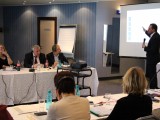Overview 2020
Cross-border cooperation in the cross-border area between Hungary and Romania will continue in the funding period 2014-2020. This page will keep you informed about all developments and decisions related to the Interreg V-A Romania-Hungary 2014-2020 Programme. Please note, however, that this is not the new website of the Programme, as this will be launched at a later stage, reflecting the visual identity of the new programme.
Preparation of the Interreg V-A Romania-Hungary 2014-2020 Programme
On 4 October 2011 a high level technical meeting was held on future strategic planning where the two Member States, Hungary and Romania, agreed upon setting up a Joint Working Group (JWG) with the aim to elaborate the new programme. The JWG is the main body making decisions about the future programme and comprises national and county level stakeholders, along with advisors from the EC and the designated managing (Ministry of Regional Development and Public Administration, Romania) and national authorities (Prime Ministers Office, Hungary and Ministry of Regional Development and Public Administration, Romania).
The JWG has gathered on 11 occasions until now. A sub-group was also established having as members the presidents of the 8 county councils from the eligible area to provide a common ground for the identification and development of proposals for strategic projects.
The first milestone of the strategic planning process was the preparation and adoption of the Strategic Territorial Analysis by the JWG on 3 December 2013. The document contains a comparative analysis of the border area.
As a next step, following decision of the JWG on the thematic objectives to be selected for the future programme, the consultants prepared the Common Territorial Strategy containing the main development directions to be followed. The document was approved by the JWG on 20 June 2014.
Accordingly, the consultants were able to develop and finalise the Interreg V-A Romania-Hungary 2014-2020 Programme Document, which was adopted by the Monitoring Committee during its meeting held on 21-22 April 2015. Following its adoption by the two Member States’ governments, the document was submitted to the European Commission on 22 May 2015.
The new programme is expected to be launched in Autumn of 2015.
In order to ensure the necessary public consultation procedures, a series of events and public consultations are continuously held related to the finalisation of the programme document. We will also keep you informed in this regard through our website and via regular mailings and newsflashes in order to involve all relevant stakeholders in shaping the next programme.
Policy background
The cohesion policy of the European Union provides a framework for financing a wide range of projects and investments with the aim of encouraging economic growth in EU Member States and their regions. The policy is reviewed by the EU institutions once every seven years. The next round of programmes is to cover the period 2014 - 2020.
On 17 December 2013, the European Parliament and the Council adopted the new legislative package governing Cohesion Policy investments for 2014-2020. According to the current set-up, European Territorial Cooperation has even been reinforced as separate cohesion goal by dedicating a legislative act (Regulation no. 1299/2013) to the specific provisions for this field. The existing strands of cross-border, transnational and interregional cooperation have been maintained, thus the future of the HURO Programme is ensured.
A comprehensive list of thematic objectives has been defined in the new ERDF Regulation (Regulation (EU) No. 1301/2013). Of the 11 thematic objectives, ETC programmes may choose a maximum of 4 thematic objectives to which at least 80% of the ERDF allocation shall be concentrated, ensuring a stronger result orientation that incentives good projects. The thematic objectives, and thus the development directions chosen need to reflect the national/regional priorities of participating countries, and respond to the strategic needs of the programme area, analysing common problems and their strategic solutions, as well as practical experience from the current period.
Preparation of operational programmes for the next period must also take account of the Europe 2020 strategy as well as the Strategy for the Danube Region, and contain proposals that will contribute to the attainment of the targets set out in their agendas.
How to find out more about the new Programme?
Until the establishment of the Joint Secretariat, please address your inquiries about the Programme to the Managing Authority established within the Ministry of Regional Development and Public Administration, in Bucharest, Romania:
Directorate General for European Funds
Managing Authority of the Interreg V-A Romania-Hungary 2014-2020 Programme
B-dul. Libertăţii, Nr. 12, Sector 5, Bucureşti
Tel: +40372 111 326
Fax: +40372 111 456
rohu@mdrap.ro
www.mdrap.ro
Useful documents
European Structural and Investment Funds Regulations 2014-2020
Guidance on European Structural and Investment Funds 2014-2020
